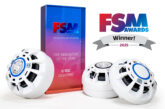
Alex Smith, Technical Director at Flexicon, details some of the common myths around fire protection performance for electrical cabling.
BS 7671 refers to EN 61386 for flexible conduit performance requirements, including fire. However, this standard for conduit systems only addresses non-flame propagation (self-extinguishing) – and no other fire performance properties (enhanced flame retardancy, smoke and toxic fume emission) are included.
This can lead to a potentially dangerous situation where cables can be laid in flexible conduit that, by its standard, only needs to clarify if it is self-extinguishing and may not offer a comprehensive level of fire performance.
Traditionally, halogen-free conduits have been specified, often based on the common misconception that they offer comprehensive fire protection performance. With an array of differing standards in place, operators should ensure that their cable protection meets all low fire hazard criteria requirements.
Meeting low fire hazard specification
For a product to be classified as low fire hazard, it must display four clearly defined characteristics: it must be highly flame retardant, have low smoke emission, low toxic fumes and be halogen-free.
All metal conduit systems are inherently low fire hazard as there is no plastic to burn, however most conduit systems are now plastic coated or all plastic, so their performance needs to be assessed.
Flame retardancy
First, a supplier must be able to demonstrate appropriate flame retardancy. Flammability – the measure of how difficult it is to ignite the conduit if it is exposed to a heat source – is often cited here. The minimum requirement is that the product is self-extinguishing, according to conduit system standard EN 61386.
To assess how flame retardant a material is, the normal test method is to measure the Limiting Oxygen Index (LOI) according to BS EN ISO 4589-2. This determines the percentage of oxygen that needs to be present to support combustion. The higher the LOI percentage, the greater the flame retardancy of the material.
Low smoke emission
If the conduit is involved in a fire, the smoke generated may obscure the vision of people trying to escape, or the firefighters trying to extinguish the flames. The flexible conduit specified should provide superior protection if this scenario occurs, to ensure occupants are afforded sufficient time to exit the building safely.
There are a number of fire tests, where a specified sample of material is burnt under controlled conditions in a given size smoke chamber and the smoke obscuration of a defined beam of light is measured.
Low toxicity
To test for toxicity, a specified sample of material is burnt under controlled conditions in a chamber and the fumes are analysed for various gases. The concentration of each gas is then multiplied by its toxic potency to give a toxicity index. If halogens, sulphur or phosphorus are present in a material, it is unlikely to pass the low toxicity tests.
Halogen-free
As mentioned, one of the main misconceptions is that a halogen-free material is automatically a low fire hazard product. The fact remains that a material cannot be considered as low fire hazard if it contains halogen, but as we have learnt, without the accompanying low toxicity, low smoke and flame-retardant properties, it will not meet the full criteria.
Typical halogens are fluorine, chlorine, bromine and iodine. Chlorine is the most common in PVC, fluorine is present in fluoro-polymers and bromine appears in flame retardants. All of them produce highly toxic fumes and thick smoke if exposed to a naked flame; another reason why operators may have tended to rate this area of performance above other fire hazard properties.
In conclusion
With so many areas to consider when assessing fire performance, it is important to work with a competent manufacturer or specifier. Specifying based on price alone, or by using standards that do not take all aspects of fire performance into account, could leave vital infrastructure vulnerable to failure.
Operators should expect their chosen supplier to be able to provide detailed evidence of the material properties, and the tests that have been conducted to ensure that all four criteria are met and that critical performance factors are maintained.
Browse Flexicon’s flexible conduit range here











